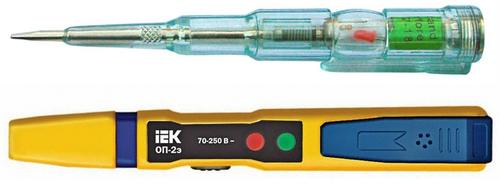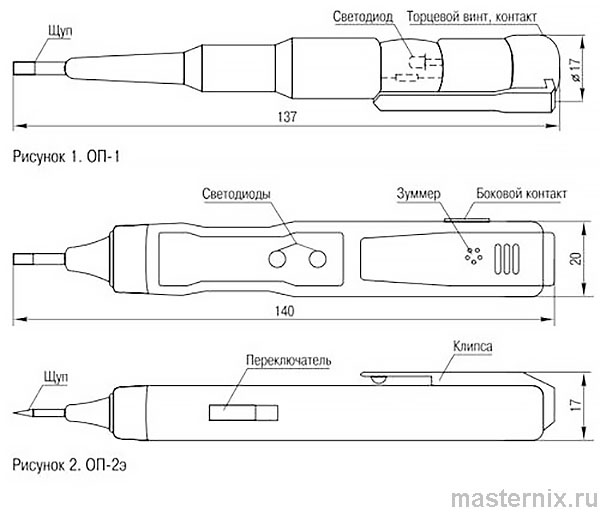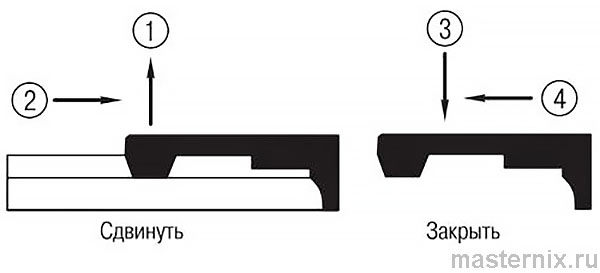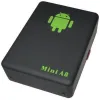
IEK OP-1, OP-2e type testers for testing electrical circuits. Operating manual
Руководство / инструкция

IEK OP-1, OP-2e Type Testers for Testing Electrical Circuits Instruction Manual
4222-002-18461115-2008 RE, PS
.
1 Purpose and Scope of Application
1.1 The OP-1, OP-2e type tester of the IEK trademark (hereinafter referred to as the tester) is made in the form of a slotted screwdriver and is intended for testing by means of light or sound indication of elements of alternating and direct current circuits in household electrical appliances, motor vehicles, etc.
1.2 The normal operating conditions of the testers are as follows:
- ambient temperature from -10 to +50 °C;
- altitude above sea level not more than 2000 m;
- average relative humidity not more than 90%;
- the surrounding air shall not be contaminated with dust, smoke, corrosive or flammable gases, as well as salt vapors.
2 Main Specifications
2.1 The main technical specifications of the testers are given in Table 1.
Table 1
| Parameter | Value | ||
| Modification | OP-1 | OP-2e | |
| AC voltage presence check, V | Contact method | 70 ÷ 250 | 70 ÷ 250 |
| Non-contact method | 70 ÷ 600 | 70 ÷ 10000 | |
| Operating frequency range, Hz | 50 ÷ 500 | 50 ÷ 500 | |
| Determination of circuit continuity and polarity of a DC source voltage, V | 1.5 ÷ 36 | 1.2 ÷ 36 | |
| Continuity check of a passive (de-energized) circuit with resistance, M? | 0 ÷ 50 | "O" - 0 ÷ 5 "L" - 0 ÷ 50 "H" - 0 ÷ 100 |
|
| Indication of high-frequency electromagnetic fields, more than mW/cm² | 5 | "L" - 5 "H" - 2 |
|
| Type of installed power supply elements | AG3 1.5 V ? 2 pcs. | AG13 1.5 V ? 2 pcs. | |
| Replaceable battery types | 392 A, LR41, 192, V3GA | LR44, 157, V13GA, A76 | |
2.2 Overall and mounting dimensions and main elements of the testers are shown in Figures 1 and 2.

..
3 Safety Requirements
3.1 In terms of protection against electric shock, the testers comply with Class II according to GOST 12.2.007.0.
3.2 The testers are not intended for use as voltage indicators according to GOST 20493 in DC and AC electrical installations with voltage up to 1000 V.
3.3 It is prohibited to operate the testers with a disassembled or cracked housing. Open the housing only for replacing batteries.
3.4 It is prohibited to use the testers as a screwdriver for tightening screws, etc.
3.5 It is not recommended to touch the screw (side contact) of the tester when using the contact method for diagnosing AC circuits.
3.6 The testers must not be used under high humidity conditions (rain, dew) for diagnosing AC circuits.
3.7 The testers must not be used to check electrical circuits energized above the voltage specified in Table 1.
4 Operating Instructions
4.1 Preparation for Operation
Before using the tester, make sure it is operational by checking the LED lighting when touching the probe with one hand and the screw or side contact with the other. If the LED does not light up, replace the batteries.
4.2 Description of Tester Functions
The OP-2e tester has a built-in mode switch (Figure 2):
- Position "O" – contact mode: red LED lights up. Used for contact determination of voltage presence, continuity of device circuits, and non-contact detection of electromagnetic fields.
- Position "L" – non-contact mode, low sensitivity: green LED lights up and buzzer operates. Used for non-contact detection of voltage presence, electromagnetic fields, etc.
- Position "H" – non-contact mode, high sensitivity: green LED lights up and buzzer operates. Used for non-contact detection of voltage presence, electromagnetic fields, etc.
The OP-1 tester has no mode switch and is always in the mode equivalent to the "O" position of the OP-2e tester.
4.3 Diagnostics of AC Circuits
4.3.1 Contact Method
Hold the tester by the handle without touching the end screw (OP-1) or side contact (OP-2e) and touch the probe to an exposed section of the live part of the electrical installation. The LED lighting will indicate the presence of voltage.
4.3.2 Non-Contact Method
Set the OP-2e tester to "L" or "H" mode. Holding the tester by the handle, bring the probe close to the insulation of live parts (power cords, open wiring, plugs, sockets, switches, and appliance housings). LED lighting (buzzer sound) confirms the presence of mains voltage. To increase sensitivity, touch the end screw (OP-1) or side contact (OP-2e) with your finger, or hold the tester by the probe and bring the side surface of the handle to the tested section of the circuit.
4.4 Diagnostics of DC Sources
When diagnosing DC sources and checking passive circuits, to ensure high sensitivity, hold the tester by the handle while touching the end screw (OP-1) or side contact (OP-2e) with your finger.
4.4.1 Determining Battery Polarity
Hold the tester in your hand and touch the end screw (OP-1) or side contact (OP-2e) with your finger. Sequentially touch the probe to each battery terminal while simultaneously touching the other free terminal with the finger of the other hand. LED lighting indicates that the probe is touching the positive terminal.
4.4.2 Condition Assessment
Hold the tester in your hand and touch the end screw (OP-1) or side contact (OP-2e) with your finger. Touch the negative terminal of the galvanic cell with the probe of the tester. At the same time, touch the positive terminal with your free hand. A discharged galvanic cell will show weak light indication, while a charged one will have no indication.
4.5 Continuity Check of Passive (De-Energized) Circuits
Touch one end of the circuit with the probe of the tester and the other end with the fingers of your free hand. Continuity will be confirmed by LED lighting, while an open circuit will be indicated by the absence of lighting.
4.6 Evaluation of Radiation from a TV or Computer Monitor Screen
Set the OP-2e tester to "L" or "H" mode. Bring the tester close to the screen of a TV or computer monitor. The LED lights up (buzzer sounds) in the area in front of the screen when the radiation flux is more than 5 mW/cm?.
4.7 Checking the Correct Positioning of Single-Pole Switches in the Phase Conductor of Household Appliances
Insert the two-pole plug of the appliance into the socket after turning off the single-pole switch, and bring the probe of the tester to the working element of the appliance (lamp base, heating element, etc.). LED lighting will indicate that the switch is located in the neutral conductor. Reverse the plug polarity and make sure the LED lighting is absent.
4.8 Checking Grounding (Connection to PE Conductor) of Metal Housings of Household Appliances (Refrigerators, Electric Stoves, Toasters, etc.)
Touch the housing of an operating electrical appliance with the probe of the tester. LED lighting will indicate the absence of grounding.
4.9 Checking Electronic Components
4.9.1 Capacitor
Connect the capacitor terminals through the tester by means of your fingers. At the moment of closing the external circuit of the capacitor, the LED will flash briefly. If the flash repeats after reversing the polarity of the capacitor connection, the capacitor is functional.
4.9.2 Diode, Rectifier
Connect the diode terminals through the tester using your fingers, then reverse the polarity. LED lighting of the tester only in one polarity indicates that the diode is functional, with the probe connected to the positive terminal of the diode in indication mode. Test rectifiers of any type according to Table 2.
Table 2
| Tester connection | Tester light indication for a functional rectifier | |
| Between terminals + and - | (probe to +) yes | (probe to -) no |
| Between terminals ~ and ~ | no | no |
| Between terminals + and ~ | (probe to +) yes | (probe to ~) no |
| Between terminals - and ~ | (probe to -) no | (probe to ~) yes |
4.9.3 Transistor (n-p-n type)
The transistor is functional if the LED lights up when the probe touches "C" (collector) and "E" (emitter) while the fingers connect the end screw (OP-1) or side contact (OP-2e) of the tester to "B" (base).
4.9.4 Transistor (p-n-p type)
The transistor is functional if the LED lights up when the probe touches "B" (base) while the fingers alternately connect the screw (side contact) to "C" (collector) and "E" (emitter).
4.9.5 Bulb, Relay Coil, Fuse, Speaker
Touch one terminal of the tested item with one hand, take the tester by the end screw (OP-1) or side contact (OP-2e) with the other hand, and touch the other terminal with the probe. If the LED lights up brightly, the item is functional; if the lighting is weak or absent, the item is faulty.
4.10 Locating a Break in a Conductor Connected to the AC Mains
Hold the tester by the probe (set OP-2e to "H" mode) and move the tester along the conductor from the point of connection to the mains. At the point of breakage, the LED will go out (the buzzer will stop sounding).
4.11 Battery Replacement

Figure 3.
4.11.1 OP-1 Tester
- Unscrew the end screw counterclockwise and remove the spring and metal plug;
- Bend back the wire holding the batteries. Install the batteries with the negative terminal inward;
- Reinstall the plug, spring, and end screw in their original positions.
4.11.2 OP-2e Tester
- Carefully lift the clip slightly upward (Figure 3, position 1), slide the clip off the tester (position 2);
- Install the batteries according to the indicated polarity;
- Install the clip back into its original position (positions 3, 4) until it clicks.
5 Transportation and Storage Conditions
5.1 Transportation of the testers in the manufacturer’s packaging is permitted by any type of covered transport that ensures protection of the testers from mechanical damage, contamination, and moisture ingress.
5.2 The testers shall be stored in the manufacturer’s packaging in premises with natural ventilation at an ambient temperature from -45 to +50 °C and relative humidity of 60–80%.
6 Warranty Obligations
6.1 The warranty period for the testers is 1 year from the date of sale, provided that the consumer complies with the rules for operation, transportation, and storage. The warranty period does not apply to batteries.
6.2 During the warranty period, contact the following address:
"IEK RUSSIA"
117545, Moscow, 1st Dorozhny proezd, building 4, structure 1
Tel.: 788-8845, 788-8846 Fax: 788-8847 www.iek.ru


